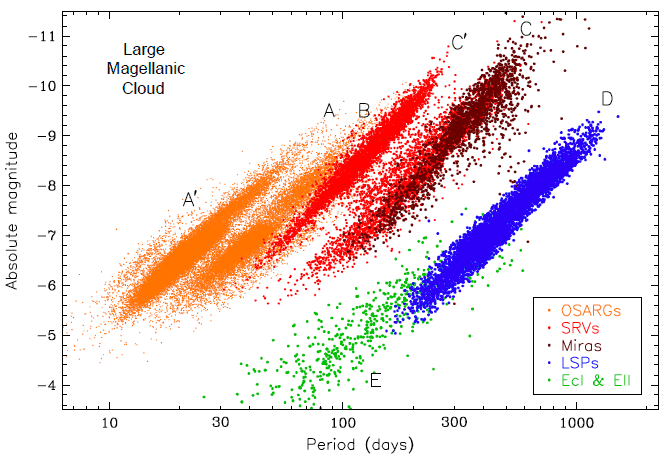Long Period Variables
Stars that evolve along the first-ascent red giant branch (RGB) or asymptotic giant branch (AGB) in the Hertzsprung-Russell diagram show, with no exception, variability due to oscillations. The amplitudes of the photometric variations increase with the bolometric luminosity of giant stars - from micromagnitudes in stars at the base of the giant branch, through millimagnitudes in OGLE small-amplitude red giants (OSARGs), tenths of a magnitude in semiregular variables, to several magnitudes in Mira stars at the tip of the AGB. Pulsating red giant and supergiant stars are collectively called long-period variables (LPVs).
The General Catalogue of Variable Stars distinguishes one more subtype of LPVs - slow irregular variables. However, this class of variable stars (i.e. objects with no evidence of periodicity) probably does not exist among pulsating red giants. It seems that all LPVs classified in the literature as irregular variables are in fact semiregular variables with an insufficient number of observations to determine their periods.
LPVs follow a series of nearly parallel period-luminosity relations labeled by Wood et al. (1999) with letters from A to E. This pattern was later extended by newly discovered ridges A', C', and others. Period-luminosity sequences A', A, B, C', and C can be attributed to different pulsation modes of LPVs. Broad sequence E is populated by eclipsing and ellipsoidal close binary systems with a red giant star as one of the components. Finally, sequence D is formed by so-called long secondary periods that are shown by at least 30% of LPVs.
 |
Period-luminosity diagram for LPVs in the Large Magellanic Cloud. Different colors refer to different types of variable red giants: orange - OSARGs, red - semiregular variables, brown - Miras, blue - long secondary periods, and green - eclipsing and ellipsoidal close binary systems containing a red giant as one of the components. As the "luminosity" we used the reddening-free Wesenheit index, defined as WJK = K - 0.686(J - K) - DM, where J and K are near-infrared magnitudes from the IRSF Catalog and DM = 18.5 mag is the distance modulus of the Large Magellanic Cloud. |
LPVs is a very numerous class of variable stars, because virtually all cool giants exhibit stellar oscillations. The OGLE Collection of Variable Stars (Soszyński et al. 2009, 2011, 2013) currently contains about 343,000 LPVs in the Galactic bulge and Magellanic Clouds. About 8500 of these stars were classified as Mira variables, 46,500 as semiregular variables, and 288,000 as OSARGs.
|
